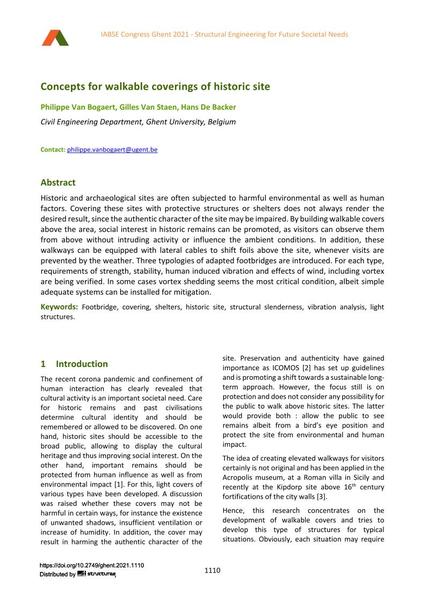Concepts for walkable coverings of historic site

|
|
|||||||||||
Bibliographic Details
| Author(s): |
Philippe Van Bogaert
(Civil Engineering Department, Ghent University, Belgium)
Gilles Van Staen Hans De Backer |
||||
|---|---|---|---|---|---|
| Medium: | conference paper | ||||
| Language(s): | English | ||||
| Conference: | IABSE Congress: Structural Engineering for Future Societal Needs, Ghent, Belgium, 22-24 September 2021 | ||||
| Published in: | IABSE Congress Ghent 2021 | ||||
|
|||||
| Page(s): | 1110-1117 | ||||
| Total no. of pages: | 8 | ||||
| DOI: | 10.2749/ghent.2021.1110 | ||||
| Abstract: |
Historic and archaeological sites are often subjected to harmful environmental as well as human factors. Covering these sites with protective structures or shelters does not always render the desired result, since the authentic character of the site may be impaired. By building walkable covers above the area, social interest in historic remains can be promoted, as visitors can observe them from above without intruding activity or influence the ambient conditions. In addition, these walkways can be equipped with lateral cables to shift foils above the site, whenever visits are prevented by the weather. Three typologies of adapted footbridges are introduced. For each type, requirements of strength, stability, human induced vibration and effects of wind, including vortex are being verified. In some cases vortex shedding seems the most critical condition, albeit simple adequate systems can be installed for mitigation. |
||||
| Keywords: |
footbridge light structures covering historic site vibration analysis shelters structural slenderness
|
||||
| Copyright: | © 2021 International Association for Bridge and Structural Engineering (IABSE) | ||||
| License: | This creative work is copyrighted material and may not be used without explicit approval by the author and/or copyright owner. |
||||
